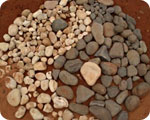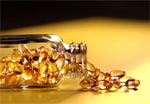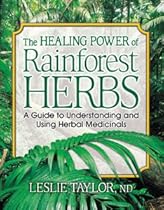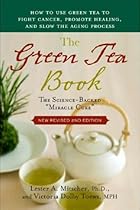Abram Hoffer, PhD, MD, FRCP(C) and Dr. Jonathan Prousjy, DPHE, DSC, ND, FRSH
See book keywords and concepts |
 Many herbal medicines are very effective for mild cases of low stomach acid. We prefer betaine HCI or niacin for the more moderate-to-severe cases. The best herbal stimulator is Gentiana lutea (gentian). It has been shown to stimulate certain receptors in the taste buds, referred to as gustatory receptors. By stimulating the gustatory receptors, there is a reflex increase in saliva and HC1 production. Other herbal bitters, such as Zingiber officinale (ginger) or Centaurium minus (common or red centuary), might work equally as well. Many herbal medicines are very effective for mild cases of low stomach acid. We prefer betaine HCI or niacin for the more moderate-to-severe cases. The best herbal stimulator is Gentiana lutea (gentian). It has been shown to stimulate certain receptors in the taste buds, referred to as gustatory receptors. By stimulating the gustatory receptors, there is a reflex increase in saliva and HC1 production. Other herbal bitters, such as Zingiber officinale (ginger) or Centaurium minus (common or red centuary), might work equally as well. |
Richard P. Brown, M.D., and Patricia L. Gerbarg, M.D.
See book keywords and concepts |
 In addition, because no one dwells in a stress-free Utopia where life unfolds exactly according to plan, we recommend a regimen of herbal and nutritional supplements that have helped us and our patients maintain a healthy balance between energy expenditure and energy renewal. Our personal and clinical experience has taught us that an integrated approach, including the judicious use of Rhodiola rosea to help enhance the body's energy production, can help us live well and happily as we grapple with unprecedented demands and pressures on our time. In addition, because no one dwells in a stress-free Utopia where life unfolds exactly according to plan, we recommend a regimen of herbal and nutritional supplements that have helped us and our patients maintain a healthy balance between energy expenditure and energy renewal. Our personal and clinical experience has taught us that an integrated approach, including the judicious use of Rhodiola rosea to help enhance the body's energy production, can help us live well and happily as we grapple with unprecedented demands and pressures on our time. |
Abram Hoffer, PhD, MD, FRCP(C) and Dr. Jonathan Prousjy, DPHE, DSC, ND, FRSH
See book keywords and concepts |
 The best herbal stimulator is Gentiana lutea (gentian). It has been shown to stimulate certain receptors in the taste buds, referred to as gustatory receptors. By stimulating the gustatory receptors, there is a reflex increase in saliva and HC1 production. Other herbal bitters, such as Zingiber officinale (ginger) or Centaurium minus (common or red centuary), might work equally as well.
The preferred form is an herbal medicine in tincture form, which is simply an alcohol-based preparation. The best herbal stimulator is Gentiana lutea (gentian). It has been shown to stimulate certain receptors in the taste buds, referred to as gustatory receptors. By stimulating the gustatory receptors, there is a reflex increase in saliva and HC1 production. Other herbal bitters, such as Zingiber officinale (ginger) or Centaurium minus (common or red centuary), might work equally as well.
The preferred form is an herbal medicine in tincture form, which is simply an alcohol-based preparation. |
Mike Adams, the Health Ranger
See article keywords and concepts |
 Something will be labeled herbal skin care or the word "herbal" will be in it and it is only one herb. It is not even the main ingredient. It is still mineral oil based stuff many of the times. I find that outrageous as well. Is this part of the motivating factor that got you moving forward with this product line?
Minka: Well that was one of the main things because I could not find anything in the store that worked for my skin because if it was natural it seemed drying and that it would really deplete my skin of nutrients. Something will be labeled herbal skin care or the word "herbal" will be in it and it is only one herb. It is not even the main ingredient. It is still mineral oil based stuff many of the times. I find that outrageous as well. Is this part of the motivating factor that got you moving forward with this product line?
Minka: Well that was one of the main things because I could not find anything in the store that worked for my skin because if it was natural it seemed drying and that it would really deplete my skin of nutrients. |
C. P. Khare
See book keywords and concepts |
 In line with the Chinese and Indian herbal traditions, it is mainly used as a stomachic, anti-inflammatory, expectorant and a nervine tonic.
In Chinese research trials, a decoction of galangal had an antibacterial action against a number of pathogens, incl. anthrax.
Research during 1988 indicated that galangal is distinctively effective against Candida albicans.
The herb's antispasmodic, antiphlogistic as well as antibacterial role has been accepted in the West. In line with the Chinese and Indian herbal traditions, it is mainly used as a stomachic, anti-inflammatory, expectorant and a nervine tonic.
In Chinese research trials, a decoction of galangal had an antibacterial action against a number of pathogens, incl. anthrax.
Research during 1988 indicated that galangal is distinctively effective against Candida albicans.
The herb's antispasmodic, antiphlogistic as well as antibacterial role has been accepted in the West. |
| Extreme toxicity makes it unsafe as a herbal medicine.
Zarnab (Arabic), Budul, Bhrangi, Chilaa, Chi-liraadh are doubtful synonyms of Taalispatra. Zarnab has been equated with Salix aegyptiaca Sprengel. National Formulary of Unani Medicine has equated Telispattar with Zarnab and Zarnab with Flacourtia cataphracta Roxb., also with Cin-namomum tamala Nees. Taalisfar (Arabic), known as Taalispatra in Punjab and Nepal, has not yet been equated scientifically with Abies spp. |
| Caution
Due to toxicity the total herb should no more be used as a herbal medicine. Its constituents should be screened and assessed for their use in modern medicine—the root for anti-estrogenic activity, and as a diuretic; leaves for leucoderma and other skin diseases; seeds for anti-tumour properties.
The herb has already fallen into disuse in China, as better alternatives have been identified for ailments covered by the herb.
Abrus preeatorius has been mentioned as Indian or wild liquorice. This nomenclature is misleading. |
David Hoffman, FNIMH, AHG
See book keywords and concepts |
 Are metabolites of herbal constituents cleared by the kidneys or in the gastrointestinal tract?
Toxicity and Adverse Effects
• How does the therapeutic dose compare with the potentially toxic dose (i.e., what is the therapeutic index)?
• Are there reports of resistance or unusual reactions?
• What is the treatment for an overdose?
Drug Interactions
• Does the combination of the herb with another therapeutic agent cause any synergism, antagonism, or changes in the effect of the herb or its metabolism?
• Will the herb affect the actions or metabolism of the other therapeutic agent? Are metabolites of herbal constituents cleared by the kidneys or in the gastrointestinal tract?
Toxicity and Adverse Effects
• How does the therapeutic dose compare with the potentially toxic dose (i.e., what is the therapeutic index)?
• Are there reports of resistance or unusual reactions?
• What is the treatment for an overdose?
Drug Interactions
• Does the combination of the herb with another therapeutic agent cause any synergism, antagonism, or changes in the effect of the herb or its metabolism?
• Will the herb affect the actions or metabolism of the other therapeutic agent? |
| In other words, drug is an herbal word!
The word pharmacology itself is derived from the Greek words pharmakon (drug) and logos (word). This branch of science is very extensive and is divided into numerous subspecialties.
Pharmacodynamics is the study of the physiological or biochemical mechanisms by which drug actions are produced, which involves identifying effects produced and the sites and mechanisms of their actions in the body. |
| This can cause some confusion when discussing herbal medicines, as the general public tends to differentiate between herbs and drugs, viewing herbs as natural and drugs as synthetic. However, both herbs and drugs contain chemical compounds that affect the body in various ways, so an understanding of pharmacology is relevant to both.
It is worth noting that the word drug is derived from the middle English drogge, which in turn is thought to come from the middle Dutch word droge, meaning "dry." Thus, our modern word drug refers to the use of dry plants in medicine. |
| In Western herbal medicine, Ephedra is considered a reliable treatment for asthma and allergic conditions. As it is both a bronchodilator and a nasal decongestant, it is useful also in bronchitis, emphysema, rhinitis, and influenza. It is contraindicated for patients with hypertension, angina pectoris, and hyperthyroidism; in those taking monoamine oxidase inhibitor drugs (MAO inhibitors); and also during pregnancy.
P-carboline Alkaloids
P-carbolines are a widely distributed class of indole alkaloids found in 23 angiosperm plant families, 3 fungi genera, and a variety of animal tissues. |
| Consider the following quotation from The Honest herbal, by Professor Varro Tyler. Charles C. Bennett, vice president of Public Education for the Arthritis Foundation, has suggested that inquiries concerning yucca be answered
"... by saying that there is no proper scientific evidence that yucca tablets are helpful in treating rheumatoid arthritis or osteoarthritis; that they are probably harmless; and that the real danger would be in taking yucca tablets instead of following proper and proven treatment procedures, which could lead to irreversible joint damage and possible disabilities. |
Rainer W. Bussmann and Douglas Sharon
See book keywords and concepts |
 Medicinal plant lore or herbal medicine is a major component of Traditional Medicine.
In Latin American countries, herbal medicine is deeply rooted, practiced extensively by indigenous groups, and frequently used by a broad cross-section of the larger society. Often it is an economically inevitable alternative to expensive Western medicine.
Traditional knowledge is transmitted from one generation to the next by traditional healers, shamans or curanderos, and has survived the rigors of the Spanish conquest, the Inquisition, and extensive mestizaje or racial intermixing. Medicinal plant lore or herbal medicine is a major component of Traditional Medicine.
In Latin American countries, herbal medicine is deeply rooted, practiced extensively by indigenous groups, and frequently used by a broad cross-section of the larger society. Often it is an economically inevitable alternative to expensive Western medicine.
Traditional knowledge is transmitted from one generation to the next by traditional healers, shamans or curanderos, and has survived the rigors of the Spanish conquest, the Inquisition, and extensive mestizaje or racial intermixing. |
C. P. Khare
See book keywords and concepts |
 The juice of leaves with black pepper (Piper nigrum) is prescribed by herbal practitioners. The active principle in aqueous leaf extract shows activity similar to insulin. (Suppl. WOI, 2000) Clinical and pharmacological trials of unripe fruit and root exhibit promising results.
Aqueous and alcoholic extract of the leaves are reported to possess cardiotonic effect on amphibian and mammalian hearts. An alkaloid, aegeline, showed sympathomimetic property, and also produced stimulation of respiration and contraction in anaesthetised cats. The juice of leaves with black pepper (Piper nigrum) is prescribed by herbal practitioners. The active principle in aqueous leaf extract shows activity similar to insulin. (Suppl. WOI, 2000) Clinical and pharmacological trials of unripe fruit and root exhibit promising results.
Aqueous and alcoholic extract of the leaves are reported to possess cardiotonic effect on amphibian and mammalian hearts. An alkaloid, aegeline, showed sympathomimetic property, and also produced stimulation of respiration and contraction in anaesthetised cats. |
| Not to be confused with Winter Cherry of Western herbal, equated with Physalis alkekengi.)
Parts used
Root, ash.
Dose
Root powder 3-6 g, ash 1-2 g. Classical use
According to the Wealth of India, it is difficult to accept Withania somnifera as the source of classical Ashwagandhaa (of Charaka and Sushruta).
Charaka divided plant substances in fifty groups according to physiological actions of their decoctions. |
Richard P. Brown, M.D., and Patricia L. Gerbarg, M.D.
See book keywords and concepts |
 Abidoff's studies combine Rhodiola rosea and Rhododendron caucasicum, we recommend separate herbal supplements. This is because Rhodiola rosea is best absorbed when taken 20 to 30 minutes before a meal, while Rhododendron caucasicum reduces fat absorption most effectively when taken right at the beginning of a meal.
Start with 200 milligrams of Rhodiola rosea Vi hour before breakfast and Vi hour before lunch—a total of 400 milligrams a day—for an optimal daytime energy boost. Add 100 to 200 milligrams of Rhododendron caucasicum right before breakfast, lunch, and/or dinner. Abidoff's studies combine Rhodiola rosea and Rhododendron caucasicum, we recommend separate herbal supplements. This is because Rhodiola rosea is best absorbed when taken 20 to 30 minutes before a meal, while Rhododendron caucasicum reduces fat absorption most effectively when taken right at the beginning of a meal.
Start with 200 milligrams of Rhodiola rosea Vi hour before breakfast and Vi hour before lunch—a total of 400 milligrams a day—for an optimal daytime energy boost. Add 100 to 200 milligrams of Rhododendron caucasicum right before breakfast, lunch, and/or dinner. |
Mike Adams, the Health Ranger
See article keywords and concepts |
 New rainforest herbal concentrates
One company that's gaining recognition in the United States has developed a technology to concentrate and encapsulate liquid rainforest botanicals inside a veggie capsule, allowing consumers to get all the medicinal benefits of rainforest herbs without needing to taste them on the way down.
This is a company I've mentioned before on NewsTarget, but this new product line is so innovative that it deserves additional recognition. It is by far the most convenient and medicinally-dense herbal delivery format that I've seen in the industry. New rainforest herbal concentrates
One company that's gaining recognition in the United States has developed a technology to concentrate and encapsulate liquid rainforest botanicals inside a veggie capsule, allowing consumers to get all the medicinal benefits of rainforest herbs without needing to taste them on the way down.
This is a company I've mentioned before on NewsTarget, but this new product line is so innovative that it deserves additional recognition. It is by far the most convenient and medicinally-dense herbal delivery format that I've seen in the industry. |
Peter h. Fraser and Harry Massey
See book keywords and concepts |
 Eventually, he emulated Edward Bach, creator of the Bach Flower Remedies, which are herbal medicinals said to capture the healing essence of plants. Peter was a nature lover and herbalist, so he decided to see if there were plants from the Australian environment that might help treat his symptoms. Peter had an early version of an electronic imprinting device, so he could, if he needed to, make homeopathic-like remedies from any flowers or plants that seemed promising in treating his symptoms. Eventually, he emulated Edward Bach, creator of the Bach Flower Remedies, which are herbal medicinals said to capture the healing essence of plants. Peter was a nature lover and herbalist, so he decided to see if there were plants from the Australian environment that might help treat his symptoms. Peter had an early version of an electronic imprinting device, so he could, if he needed to, make homeopathic-like remedies from any flowers or plants that seemed promising in treating his symptoms. |
Leslie Taylor, ND
See book keywords and concepts |
 Not only is it a great natural foaming agent, it provides natural antibiotic and healing properties for the skin and hair.
Traditional In Brazil, juazeiro is prepared in different ways depending on what it is Preparation employed for. For fevers: 20 g of dried bark is decocted in 1 liter of water and V2 cup amounts are taken two to three times daily. This decoction is also used to prevent cavities by using it as a mouth gargle. Not only is it a great natural foaming agent, it provides natural antibiotic and healing properties for the skin and hair.
Traditional In Brazil, juazeiro is prepared in different ways depending on what it is Preparation employed for. For fevers: 20 g of dried bark is decocted in 1 liter of water and V2 cup amounts are taken two to three times daily. This decoction is also used to prevent cavities by using it as a mouth gargle. |
Stacy Malkan
See book keywords and concepts |
 Morris offered the example of Clairol herbal Essence. "Their theme line is 'the organic experience' — very smart. What's organic about their products? I don't know. I'd say not too much, but Clairol herbal Essence probably, as a product line, does more in sales than all of the natural products companies in personal care put together." He was quick to add: "I'm trying not to be judgmental because you know different companies have different values and do things differently. But it's a question of how you handle new knowledge. Morris offered the example of Clairol herbal Essence. "Their theme line is 'the organic experience' — very smart. What's organic about their products? I don't know. I'd say not too much, but Clairol herbal Essence probably, as a product line, does more in sales than all of the natural products companies in personal care put together." He was quick to add: "I'm trying not to be judgmental because you know different companies have different values and do things differently. But it's a question of how you handle new knowledge. |
Paul D. Blanc, M.D.
See book keywords and concepts |
 In 1996, five years before microwave popcorn lung, an outbreak of bronchiolitis obliterans in Taiwan was caused by an herbal diet aid.10 At about the same time, another herbal weight loss treatment caused more than a hundred cases of severe kidney damage in Belgium. Nearly half of the victims eventually required dialysis or kidney transplant. As more time elapsed, it became clear that these same patients were also developing cancer.11
Synthetic chemicals never intended for anything other than industrial use have also found their way into the alternative health marketplace. In 1996, five years before microwave popcorn lung, an outbreak of bronchiolitis obliterans in Taiwan was caused by an herbal diet aid.10 At about the same time, another herbal weight loss treatment caused more than a hundred cases of severe kidney damage in Belgium. Nearly half of the victims eventually required dialysis or kidney transplant. As more time elapsed, it became clear that these same patients were also developing cancer.11
Synthetic chemicals never intended for anything other than industrial use have also found their way into the alternative health marketplace. |
Mike Adams, the Health Ranger
See article keywords and concepts |
 So, for instance, our herbal extracts are our standardized extracts. They are very concentrated and highly reliable in terms of what therapeutic actions you're going to get from them.
For our herbal concentrate, you use one drop per five pounds of body weight. With most other herbal companies, you have to use a quarter to one-half teaspoon per 10 or 20 pounds of body weight. That is a lot more product to try and get into the body. Now, when you're putting a lot more product into the body, the body has to digest and utilize that in order to extract the therapeutic ingredient. So, for instance, our herbal extracts are our standardized extracts. They are very concentrated and highly reliable in terms of what therapeutic actions you're going to get from them.
For our herbal concentrate, you use one drop per five pounds of body weight. With most other herbal companies, you have to use a quarter to one-half teaspoon per 10 or 20 pounds of body weight. That is a lot more product to try and get into the body. Now, when you're putting a lot more product into the body, the body has to digest and utilize that in order to extract the therapeutic ingredient. |
Abram Hoffer, PhD, MD, FRCP(C) and Dr. Jonathan Prousjy, DPHE, DSC, ND, FRSH
See book keywords and concepts |
 There are no side effects to herbal bitters. Any healthcare provider can prescribe these herbal medicines or they might be available at your local health food store.
If you are unable to locate herbal bitters, lemon juice or apple cider vinegar is an option. Try 1 teaspoon of lemon juice or apple cider vinegar 15 to 20 minutes before meals, three times each day.
Enteric-Coated Peppermint Oil (ECPO)
Supplementing with enteric-coated peppermint oil (ECPO) can be extremely helpful, especially in cases where there is overgrowth of bacteria in the small intestine. There are no side effects to herbal bitters. Any healthcare provider can prescribe these herbal medicines or they might be available at your local health food store.
If you are unable to locate herbal bitters, lemon juice or apple cider vinegar is an option. Try 1 teaspoon of lemon juice or apple cider vinegar 15 to 20 minutes before meals, three times each day.
Enteric-Coated Peppermint Oil (ECPO)
Supplementing with enteric-coated peppermint oil (ECPO) can be extremely helpful, especially in cases where there is overgrowth of bacteria in the small intestine. |
Steven V. Joyal
See book keywords and concepts |
 FROZEN WATERMELON DELIGHT
Serves 2
1% cups ice cubes
1 cup seedless watermelon, coarsely chopped
1 cup lemon-flavored herbal tea at room temperature
Place all ingredients into a blender and process on high until smooth.
?DAY 5 Breakfast ?
Quinoa Breakfast*
Sliced hard-boiled egg Green tea
?DAY 5 Lunch ?
Curried Sardines* Modified Waldorf Salad* herbal tea
?DAYS Dinner ? FROZEN WATERMELON DELIGHT
Serves 2
1% cups ice cubes
1 cup seedless watermelon, coarsely chopped
1 cup lemon-flavored herbal tea at room temperature
Place all ingredients into a blender and process on high until smooth.
?DAY 5 Breakfast ?
Quinoa Breakfast*
Sliced hard-boiled egg Green tea
?DAY 5 Lunch ?
Curried Sardines* Modified Waldorf Salad* herbal tea
?DAYS Dinner ? |
Richard P. Brown, M.D., and Patricia L. Gerbarg, M.D.
See book keywords and concepts |
 You'll find guidelines for a high-energy diet in chapter 15, along with recommendations for our favorite energy-boosting herbal and nutritional supplements.
Energy Law #2: Your Energy Supply Is Unique and Constantly Fluctuating
Two guiding principles are at work here. First, the ebb and flow of your energy level is as individual as your thumbprint. While a coworker may seem to thrive on 5 or 6 hours of sleep a night or never need a break during the day, the same may not hold true for you. In reality, everyone requires periods of recovery to perform at a consistently high level. You'll find guidelines for a high-energy diet in chapter 15, along with recommendations for our favorite energy-boosting herbal and nutritional supplements.
Energy Law #2: Your Energy Supply Is Unique and Constantly Fluctuating
Two guiding principles are at work here. First, the ebb and flow of your energy level is as individual as your thumbprint. While a coworker may seem to thrive on 5 or 6 hours of sleep a night or never need a break during the day, the same may not hold true for you. In reality, everyone requires periods of recovery to perform at a consistently high level. |
Lester A. Mitscher and Victoria Toews
See book keywords and concepts |
 Oolongs, Semi-fermented Teas, and Most herbal Blends
Steep in water at the second boil. This water is dancing and hissing with impatience. There are bubbles rising across the entire surface; it's starting to steam, on the verge of erupting. Water on the second boil will register between 180° F and 195° F.
Heavy Black Teas and Herbals With Roasted Ingredients
Steep in water at the third boil. Water at a full, rollicking boil is what's needed to release the full flavors of heavy traditional teas and hearty herb blends. You don't need a thermometer to identify water on the third boil. Oolongs, Semi-fermented Teas, and Most herbal Blends
Steep in water at the second boil. This water is dancing and hissing with impatience. There are bubbles rising across the entire surface; it's starting to steam, on the verge of erupting. Water on the second boil will register between 180° F and 195° F.
Heavy Black Teas and Herbals With Roasted Ingredients
Steep in water at the third boil. Water at a full, rollicking boil is what's needed to release the full flavors of heavy traditional teas and hearty herb blends. You don't need a thermometer to identify water on the third boil. |
Leslie Taylor, ND
See book keywords and concepts |
 Dracontium longipes, D. loretense, D. peruviuanum, and D. asperum. While all four species are indigenous to the Amazon, D. aspe-rum is more prevalent in the rainforests of Brazil, Suriname, and Guyana; longipes, loretense, and peruviuanum are more prevalent in Peruvian and Ecuadorian rainforests.
Ethnobotanically, jergon sacha is considered a signature plant: the plant's indigenous uses are directly related to its appearance. In this particular case, the trunk-like stem and its mottled coloring closely resembles a poisonous snake indigenous to the areas in which it grows. Dracontium longipes, D. loretense, D. peruviuanum, and D. asperum. While all four species are indigenous to the Amazon, D. aspe-rum is more prevalent in the rainforests of Brazil, Suriname, and Guyana; longipes, loretense, and peruviuanum are more prevalent in Peruvian and Ecuadorian rainforests.
Ethnobotanically, jergon sacha is considered a signature plant: the plant's indigenous uses are directly related to its appearance. In this particular case, the trunk-like stem and its mottled coloring closely resembles a poisonous snake indigenous to the areas in which it grows. |
| A closely related species, T. ulmifolia, is similar in appearance, but it has different traditional medicinal uses. The botanical Latin name of the plant, Turnera aphrodisiaca, describes its ancient use as an aphrodisiac.
Damiana was recorded to be used as an aphrodisiac in the ancient Mayan civilization, as well as for "giddiness and loss of balance." A Spanish missionary first reported that the Mexican Indians made a drink from the damiana leaves, added sugar, and drank it for its purported power to enhance lovemaking. |
| The animal studies conducted to date indicate no toxicity at any of the dosages used, indicating that it is a safe natural remedy.
Depending on what it is employed for, generally V2-l cup of a whole herb infusion one to three times daily or 1-2 ml of a 4:1 tincture twice daily is used. If desired, 2-A g of powdered whole herb (depending on body weight) in tablets or capsules or stirred into water or juice twice daily can be substituted (since the active sterol chemicals are completely water soluble). |
| There have been some sporadic problems in product quality—mostly involving other leaves (cheaper fillers) added as adulterants. Mango leaves are a common adulterant in South America but, in at least one documented case, a yerba mate commercial product sold in Scotland was adulterated with a plant (in the belladonna family) containing pyrrolizidine alkaloids—which caused negative side effects in one consumer. True yerba mate, however, is considered a safe supplement and is on the FDA's GRAS list (generally regarded as safe). |












